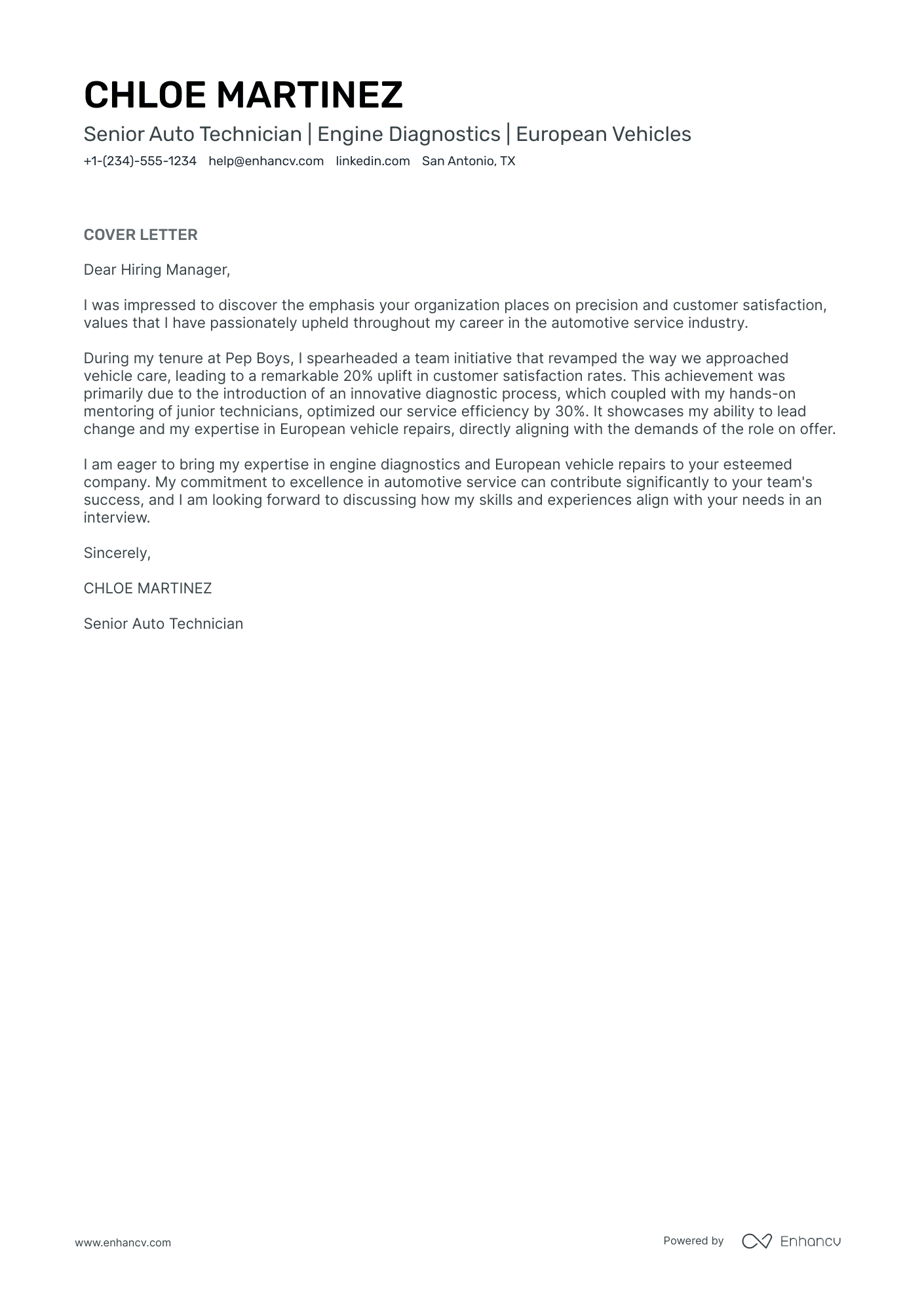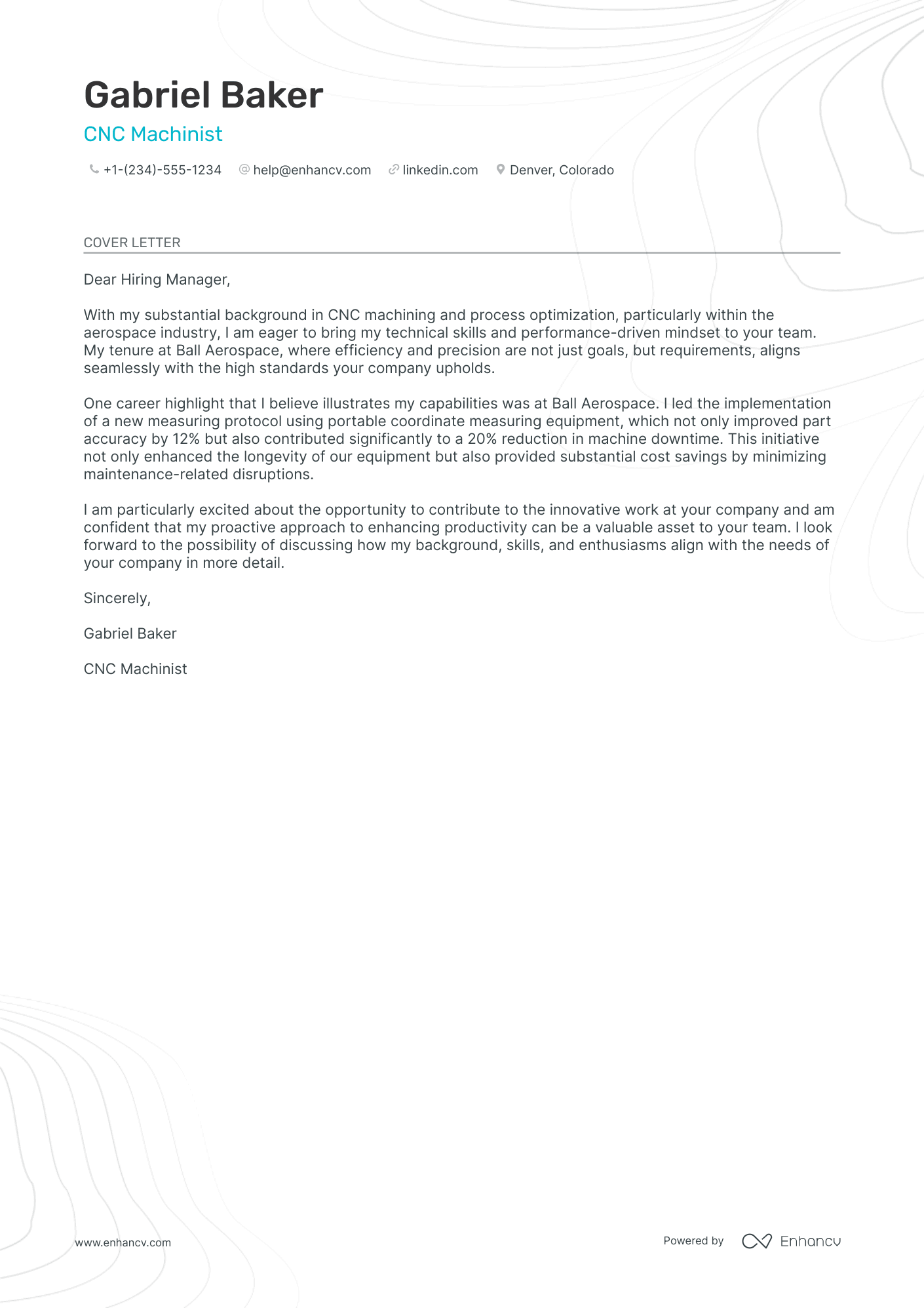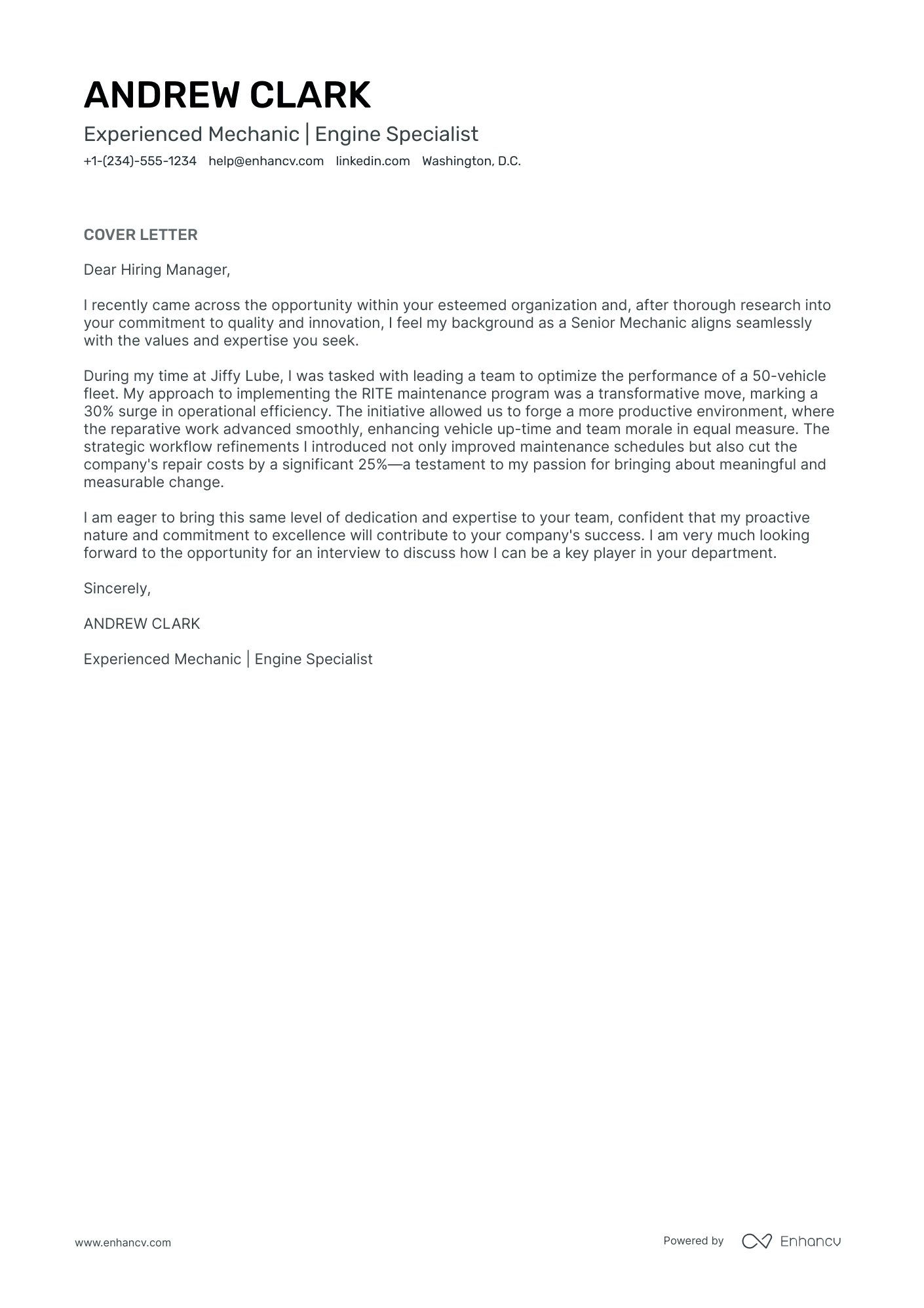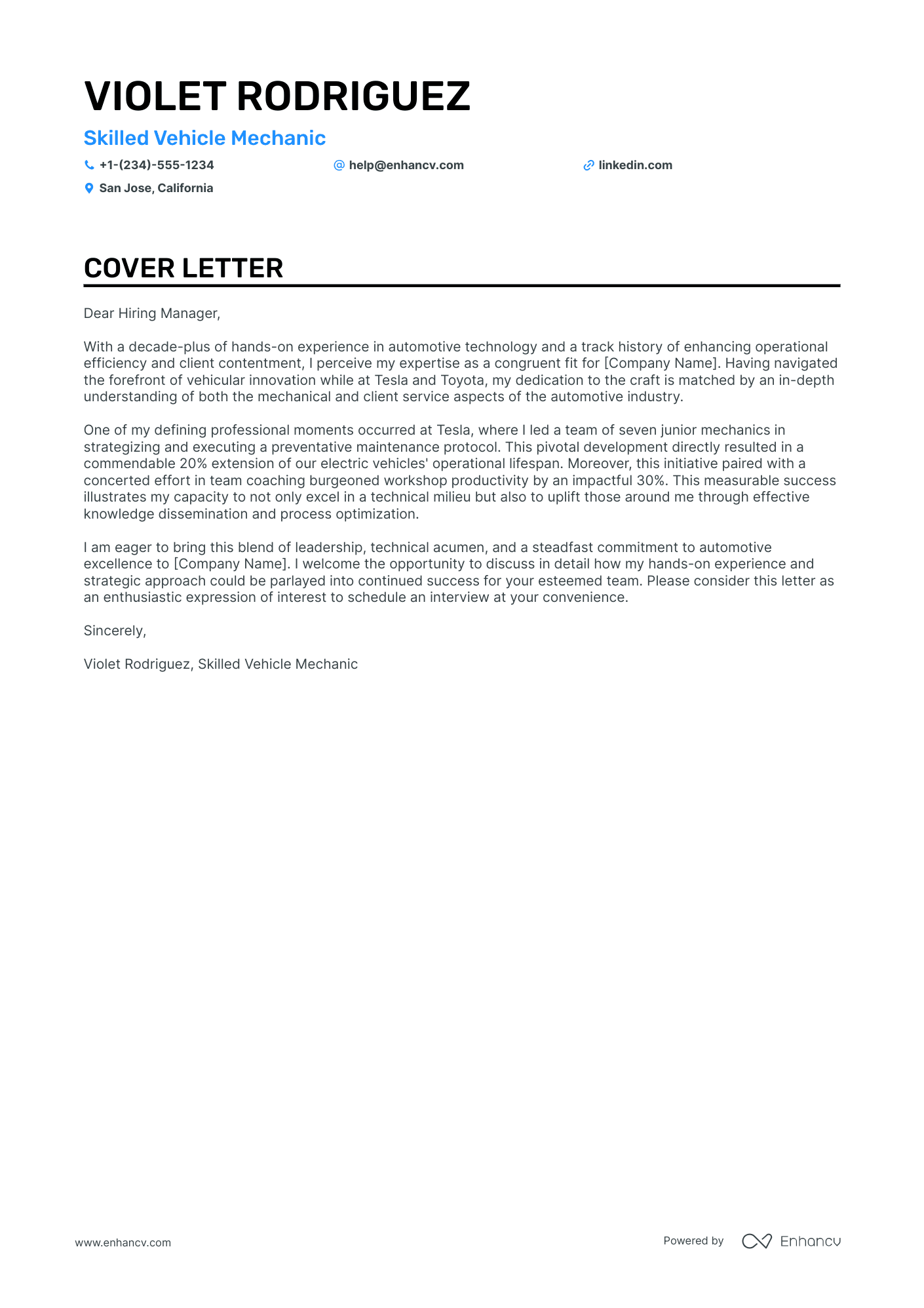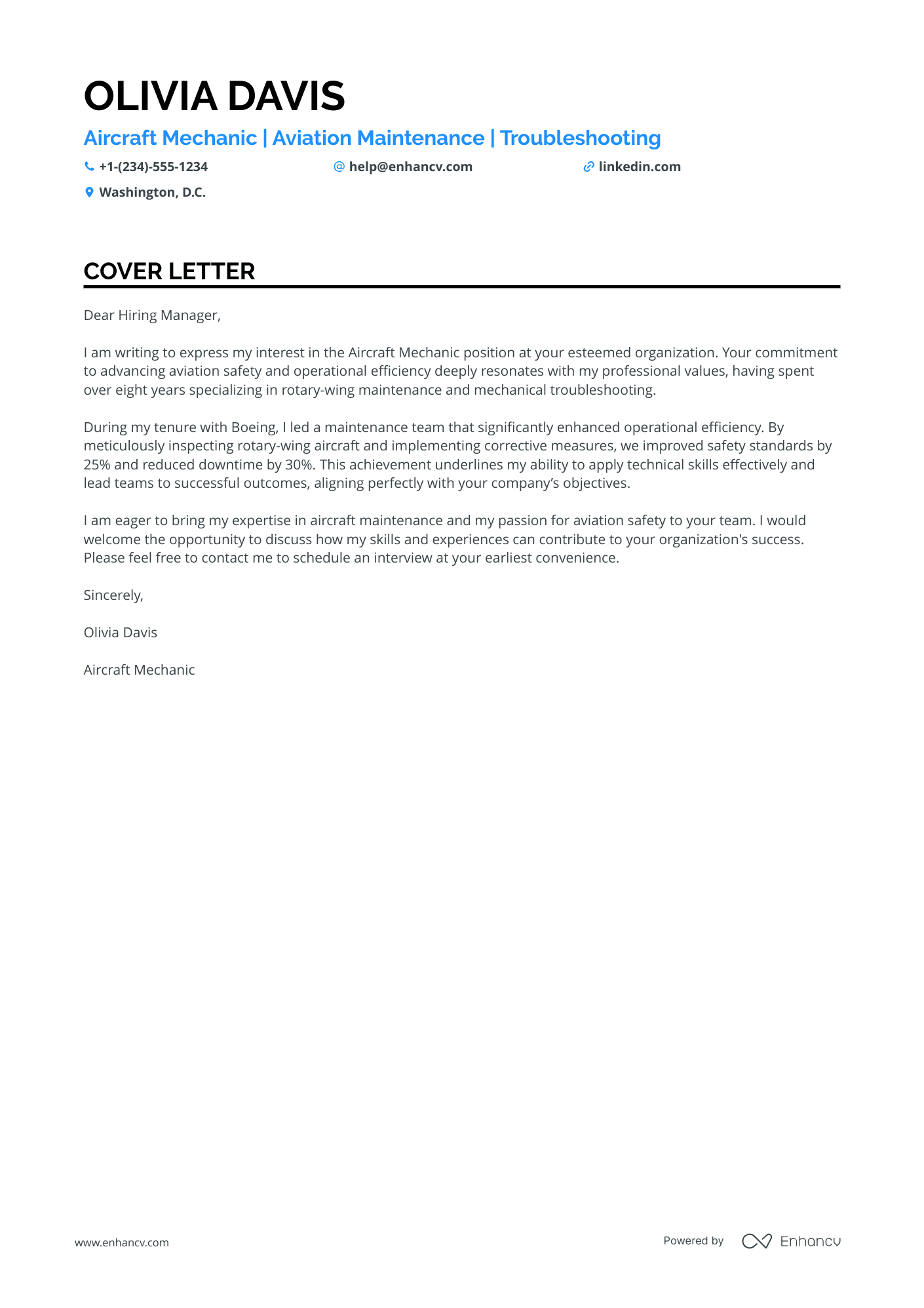Embarking on the job hunt, you've probably stumbled upon the crucial step of crafting a mechanic cover letter - an often daunting task that can make or break your application. While your resume lists your qualifications, your cover letter is your chance to impress with a compelling story of your proudest professional achievement, steering clear of clichés and irrelevant details. Remember, brevity is key; this one-page introduction is not just a formality but a gateway to your future.
- Making excellent use of job-winning real-life professional cover letters;
- Writing the first paragraphs of your mechanic cover letter to get attention and connect with the recruiters - immediately;
- Single out your most noteworthy achievement (even if it's outside your career);
- Get a better understanding of what you must include in your mechanic cover letter to land the job.
Let the power of Enhancv's AI work for you: create your mechanic cover letter by uploading your resume.
If the mechanic isn't exactly the one you're looking for we have a plethora of cover letter examples for jobs like this one:
- Mechanic resume guide and example
- Electrician cover letter example
- Regional Property Manager cover letter example
- Resident Assistant cover letter example
- Maintenance Manager cover letter example
- Housekeeping Manager cover letter example
- Electrician Apprentice cover letter example
- Diesel Mechanic cover letter example
- Hospital Housekeeping cover letter example
Drop your resume here or choose a file.
PDF & DOCX only. Max 2MB file size.
Mechanic cover letter example
Mia Williams
Denver, Colorado
+1-(234)-555-1234
help@enhancv.com
- Emphasize relevant experience: The cover letter highlights the candidate's role as a Senior Mechanical Technician at Halliburton, where they enhanced system diagnostics and reduced energy consumption. This showcases the applicant's relevant background and specific experiences that align with the new role's requirements.
- Demonstrate impact with examples: By mentioning the leadership of a revamping project that improved productivity by 10%, the cover letter provides a concrete example of the candidate’s capability to implement efficient solutions and achieve notable outcomes, which is crucial for a Maintenance Specialist position.
- Align personal values with company goals: The cover letter is tailored to the company’s commitment to efficiency and sustainability, illustrating the candidate’s shared values and reinforcing the notion that they will fit well within the company culture and contribute to its mission.
What are the basics of the design or format of your mechanic cover letter?
To start, here's a reminder for you: the Applicant Tracker System (or software that is used to assess candidate profiles), won't be reading your mechanic cover letter.
Recruiters enjoy reading mechanic cover letters with a standardized format that uses:
- the same font as the resume (e.g. modern ones like Raleway or Volkhov are prefered over the clichéd Times New Roman or Arial);
- single spacing to keep the content concise and organized (this is all ready for you in our cover letter templates);
- a one-inch margin to wrap around the text, like in our cover letter builder;
- PDF as a file format, as it allows your design (and visual element) to stay the same.
Finally, we can't go on without mentioning the key sections of your mechanic cover letter.
In the top one-third, make sure to include a header (with your contact information, name, role, and date), a salutation, and an introduction.
Next, follows the heart and soul of your mechanic cover letter or its body.
End your mechanic cover letter with a closing paragraph and, if you wish, a signature.
Skip the hassle of writing a cover letter. Use our free cover letter generator and get it done in moments.
The top sections on a mechanic cover letter
Header: This section includes your contact information and the date, making it easy for the recruiter to reach out to you for an interview or further discussion about the mechanic position.
Greeting: Personalize your cover letter by addressing it to the specific hiring manager or recruiter, demonstrating your attention to detail and respect for the company’s personnel.
Introduction: Quickly engage the reader by stating your interest in the mechanic role and mentioning your most relevant experience or credentials that align with the job description.
Professional Experience Highlights: Detail specific mechanical projects or repairs you have performed that showcase your technical skills, problem-solving abilities, and experience with the type of work required in the job you're applying for.
Closing and Call to Action: End with a strong closing statement that reiterates your enthusiasm for the mechanic position, and politely encourage the recruiter to take the next step by arranging an interview or discussion.
Key qualities recruiters search for in a candidate’s cover letter
- Hands-on experience with vehicle repairs and maintenance work: Demonstrates that the candidate has practical skills and can handle work on various types of vehicles.
- Proficiency in diagnostic equipment and automotive repair software: Shows the ability to accurately diagnose issues and efficiently repair them using modern technology.
- ASE (Automotive Service Excellence) certification or equivalent qualifications: Indicates a recognized level of professional expertise and knowledge in automotive repair.
- Strong problem-solving skills: Essential for diagnosing complex issues and finding effective solutions in a timely manner.
- Physical dexterity and stamina: Necessary to perform manual repairs, work with tools, and endure long periods of standing or bending.
- Customer service skills and experience: Reflects the ability to communicate effectively with clients, explain technical details, and ensure customer satisfaction.
Greeting recruiters with your mechanic cover letter salutation
What better way to start your conversation with the hiring manager, than by greeting them?
Take the time to find out who the professional, recruiting for the role, is.
Search on LinkedIn, the company website. And for those still keen on making a fantastic first impression, you could even contact the organization, asking for the recruiter's name and more details about the job.
Address recruiters in the mechanic greeting by either their first name or last name. (e.g. "Dear Anthony" or "Dear Ms. Smarts").
If you're unable to discover the recruiter's name - don't go for the impersonal "To whom it may concern", but instead use "Dear HR team".
List of salutations you can use
- Dear Hiring Manager,
- Dear [Company Name] Team,
- Dear [Department Name] Team,
- Dear [Hiring Manager's Name],
- Dear Ms./Mr. [Last Name],
- Dear Dr. [Last Name],
Your mechanic cover letter intro: showing your interest in the role
On to the actual content of your mechanic cover letter and the introductory paragraph.
The intro should be no more than two sentences long and presents you in the best light possible.
Use your mechanic cover letter introduction to prove exactly what interests you in the role or organization. Is it the:
- Company culture;
- Growth opportunities;
- Projects and awards the team worked on/won in the past year;
- Specific technologies the department uses.
When writing your mechanic cover letter intro, be precise and sound enthusiastic about the role.
Your introduction should hint to recruiters that you're excited about the opportunity and that you possess an array of soft skills, e.g. motivation, determination, work ethic, etc.
That one achievement in your mechanic cover letter body
The lengthiest part of your mechanic cover letter is the body.
Within the next three to six middle paragraphs, present yourself as the best candidate for the role.
How can you do that without retelling your whole professional resume?
Select one key achievement that covers job-crucial skills and technologies (and is memorable).
Within the body of your mechanic cover letter, aim to tell the story of how you achieved your success. Also, write about how this would help out your potential team.
Closing remarks to end your mechanic cover letter
Of course, you'll have to show gratitude to the recruiters, who have assessed your profile at the end of your mechanic cover letter .
A "Thank you for the consideration" would work wonders, instead of the standard "Sincerely yours".
Do you want to make an even better impression?
Close off your mechanic cover letter by promising how you see yourself excelling in the role and the positive impact you'd bring about.
A sentence that encourages some further action on the recruiter's end could also be a good way to close off the communication (e.g. provide your availability for an interview).
Mechanic cover letter advice for candidates with no experience
If you're worried about writing your Mechanic cover letter and have no professional experience, we sure have some advice for you.
Turn recruiters' attention to your transferable or relevant skills gained thanks to your life and work experience.
Instead of writing about past jobs, focus on one achievement (whether from your volunteering experience, education, etc.) and the skills it has helped you build.
Alternatively, you could focus your Mechanic cover letter on your career objectives and goals. Always remember to make those relevant to the job you're applying for by detailing how you see yourself growing as part of the company.
Recruiters would be way more impressed with candidates who fit the job profile and can bring about plenty of skills and vision to the table.
Key takeaways
Within this Enhancv guide, we've provided you with plenty of advice and inspiration on writing your mechanic cover letter:
- Always make sure your mechanic cover letter is tailored to the role you're applying for to make a good impression on recruiters;
- In your mechanic cover letter include a header (with your name, the role you're applying for, date, and contact details) and an introduction of up to two sentences that highlight your key accomplishment or why you'd fit the role;
- Focus your mechanic cover letter body on one sole achievement through your career and all the valuable lessons, skills, and know-how you've learned (that are relevant to the role);
- Ensure your mechanic cover letter closing statement isn't generic and includes either a call to action or a promise;
- If you lack professional experience, shift recruiters' focus to a relevant achievement (thanks to your academic or versatile experience) or toward your dreams and goals for professional growth.
Mechanic cover letter examples
By Role
Automotive Technician
CNC Machinist
Machine Operator
Machinist
Diesel Mechanic
Maintenance Mechanic
Vehicle Mechanic
Mechanic Supervisor
Aircraft Mechanic
- Focus on Relevant Experience: The cover letter highlights the candidate's specialized experience in rotary-wing maintenance and mechanical troubleshooting, which is crucial for the Aircraft Mechanic position.
- Quantifiable Achievements: The candidate mentions specific metrics, such as improving safety standards by 25% and reducing downtime by 30%, to demonstrate their ability to deliver concrete results.
- Alignment with Company Goals: The letter stresses how the applicant's values align with the company's commitment to aviation safety and operational efficiency, showing a good cultural fit.
- Leadership Qualities: By discussing their role in leading a maintenance team and driving performance improvements, the candidate showcases leadership skills, which are valuable in team-based work environments like aviation maintenance.
